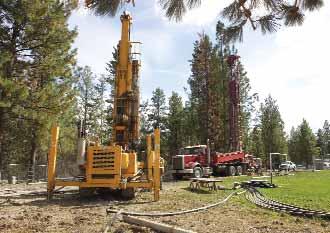
3 minute read
Terasen Gas helping schools take big steps towards reducing their carbon footprint
Terasen Gas helping schools take big steps towards reducing their carbon footprints




Brent Hunt, energy solutions manager –Terasen Gas (left), stands with Harold Schock, energy and sustainability manager – School District No. 23, at Helen Gorman Elementary School as the geoexchange system retrofit takes place.
It’s no secret: heating and cooling the vast hallways and spaces of a school can leave a fairly hefty carbon footprint. That’s why Terasen Gas is working hard to help school districts find more energy-efficient ways to provide heating and cooling. For School District No. 23, the wheels are already in motion at Helen Gorman Elementary in West Kelowna. An agreement with Terasen Gas will result in the school’s traditional heating, ventilating, and air conditioning (HVAC) system being upgraded to an energy-efficient geoexchange system.
Geoexchange systems provide many benefits for developers, building owners and end-users, ranging from indoor comfort, to benefitting the environment, to stable rates which provide financial certainty regarding the price of energy.
“We’ve been tasked with reducing our emissions, and Terasen Gas has provided an innovative and cost-effective way to help us achieve this goal,” says Larry Paul, secretary treasurer at School District 23 in central Kelowna. “This system will substantially reduce our natural gas consumption and support the province’s climate action goals.”
Terasen Gas’s geoexchange systems are an extremely effective way to reduce energy use in a building. By using ground-source heat technology, the system captures heat from the earth and circulates it throughout the building. In warmer months, it generates space cooling. The end result is reduced energy consumption, resulting in a significant reduction in greenhouse gas emissions (GHGs) and a smaller carbon footprint.
“As one of the first utility companies in Canada to include alternative energy solutions as part of its regulated energy service offerings, our agreement with School District 23 will help them use energy efficiently and thereby benefit the environment,” says Doug Stout, vice
Geoexchange systems are one of Terasen Gas’s principal alternative energy solutions, and can be implemented in both new construction and in retrofits such as Helen Gorman Elementary.

The geoexchange system being installed at Helen Gorman Elementary will be a costeffective way to increase energy efficiency and cut the facility’s carbon footprint.



president, energy solutions and external relations at Terasen Gas and FortisBC. “School District 23 has shown great leadership and vision in finding an innovative way to help Helen Gorman Elementary School move towards becoming carbon neutral, which also supports our efforts to encourage B.C. toward a sustainable energy future.”
The Helen Gorman Elementary School’s geoexchange system is certainly an enviable model for other schools to see how a geoexchange system can be used to help reduce their energy usage and GHGs.
In addition, Delta School District 37 is also making great strides. In collaboration with Terasen Gas, they are in the process of evaluating the implementation of alternative thermal energy solutions for schools within the Delta district. Through this collaboration, the school district is aiming to cut their carbon footprint and ultimately become carbon neutral.
As an integrated energy provider with an ongoing focus and strategy on energy efficiency and conservation, Terasen Gas is committed to developing innovative alternative energy solutions like geoexchange systems for schools.
To learn more about geoexchange and other alternative energy solutions for your school, please visit terasengas.com.

DEL Communications Inc.
Suite 300, 6 Roslyn Road, Winnipeg, Manitoba, Canada R3L 0G5 Toll Free:1.866.831.4744 | Toll Free Fax: 1.866.711.5282 www.delcommunications.com

Please support the advertisers who have helped make this publication possible.

We offer outstanding personal service and quality in the areas of: CREATIVE DESIGN | ADVERTISING SALES TRADE PUBLICATIONS | QUALIFIED SALES & EDITORIAL TEAM









